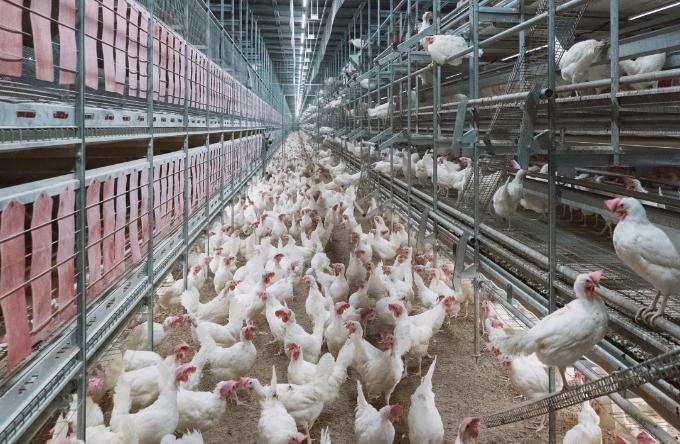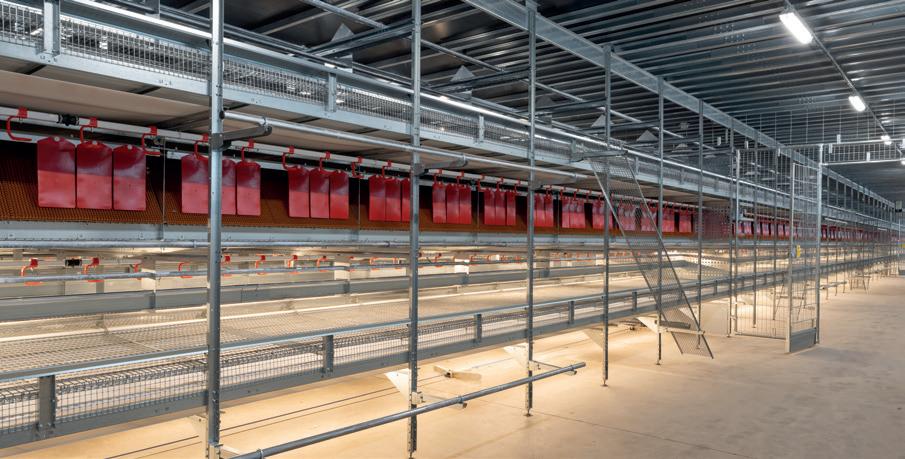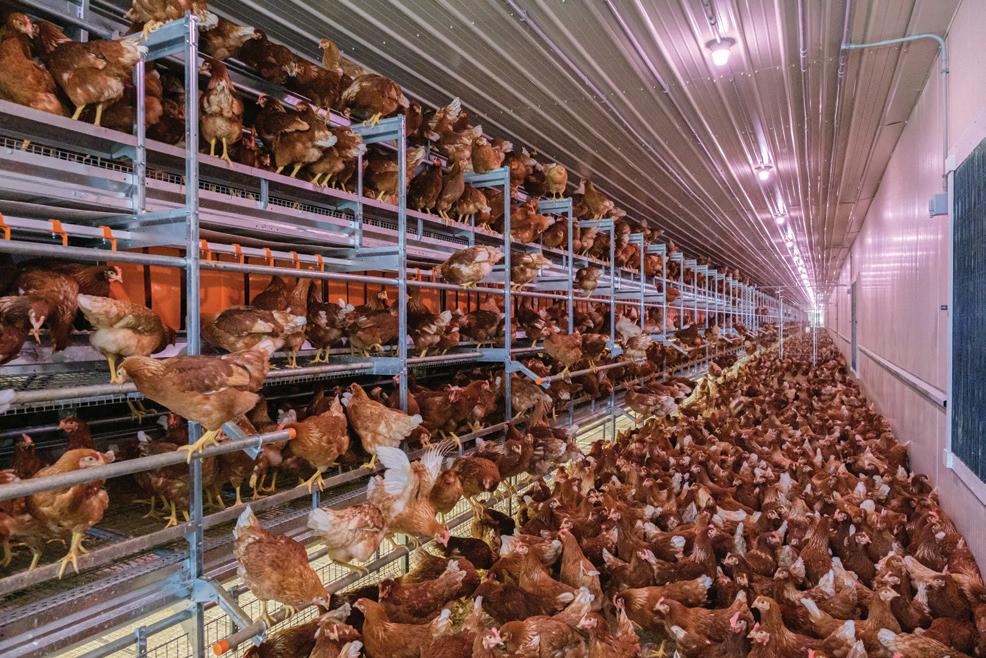

ALTERNATIVE HOUSING SUPPLEMENT
AN EGG PRODUCER’S GUIDE TO PHASING OUT CONVENTIONAL


The VOLO BABY AREA is the ideal housing system for pullets, with all the main components integrated, while the SPACE COLONY, an enriched cage for raising laying hens, allows you to customize the multi-level configuration from 3 to 12 floors.
Valli-Italy operates on the premise of passion and quality to ensure each producer receives the ideal system for their operation.


UP TO CODE
What the latest code of practice updates mean for egg farmers and housing timelines.
BY TREENA HEIN
The Code of Practice for the Care and Handling of Pullets and Laying Hens has just been updated. Finalized in August, the changes follow an amendment process launched in December 2023 and a full five-year review.
That review identified three key areas in need of attention: space per bird with round feeders, space allowance for pullets in multi-tier systems, and the maximum number of tiers permitted.
The National Farm Animal Care Council (NFACC) and Egg Farmers of Canada (EFC) note that, unlike full code updates, amendments address targeted issues, drawing on the latest scientific evidence and societal expectations for responsible care and production practices.
ABOVE:
As part of the recent code amendments, space requirements for pullets in multi-tier systems were increased, giving young birds more room to move and develop.

Enriched colony housing continues to account for the largest share of alternative housing in Canada.
There were 15 committee members handling the updates: producers, researchers, veterinarians and representatives from the processing sector, animal-welfare advocacy, retail and government. On release of the amendments in August, committee member Dr. Michelle Jendral of World Animal Protection Canada said she “was pleased to contribute to the collaborative deliberations,” adding that “this was a unique opportunity to build relationships with stakeholder groups and bring forward concerns relating to animal welfare.”
This spring, the committee gathered input to the proposed revisions during a 60-day consultation period. Responses came from Ontario (29 per cent), Alberta (12 per cent), the United States (22 per cent) and the remainder from other provinces and locations.
The top five responder groups (respondents could select multiple options) were concerned citizens, advocates, egg consumers, egg producers, animal-welfare enforcement and pullet growers.
NFACC division director Jackie Wepruk emphasizes that the committee carefully considered every viewpoint submitted during the consultation process. “A common reflection from committee members is how pleased they are with the diversity of people who provided input,” says Wepruk, “and how this enhances the final code.”
To summarize feedback and the response to it for the public, the committee produced a comprehensive What We Heard and How We Addressed It report.
FEEDBACK TO FINAL AMENDMENT
One example of how the committee incorporated feedback can be seen in the amendment on round feeders.
The committee first notes that the requirement from the 2017 code of practice “has been challenging for egg farmers that utilize round feeders, primarily because the code requirement differs significantly from manufacturer recommendations for the maximum number of birds per pan.”
They also note that the space requirement was not provided as a standalone measurement in the 2017 Code. Instead, it was expressed as a formula for converting linear feeder space to round feeder space.
In addition, producers noted that lower minimum feeder space does not appear to negatively impact bird welfare from a biological-function perspective.
Moreover, the committee also observed that there’s a lack of rationale, scientific or otherwise, for the 2017 formula, “leading the industry and the code committee to question whether this may have been included as an oversight.”
Among the feedback received, some suggested keeping the minimum round feeder space the same. Others said that if it is changed, the 2017 recommended practice to monitor feeding behaviour for competition and aggression should be elevated to a code requirement.
There was also the suggestion that if the minimum space is changed, farmers should be required to track cull data, feather condition and production data.
The committee agreed that the collection of production, health and welfare data is important, but deemed that adding a separate requirement for tracking specific data was not necessary (although it could be useful to help inform future revisions of the code where there’s a lack of science).
The committee added in its report that “ultimately, it was agreed that it would be difficult to develop audit thresholds and protocols around such a requirement. Furthermore, the code currently mandates the inspection of flocks at a minimum of twice daily.”
In the end, the code was amended to require a minimum round feeder space of 1.8 cm for each pullet from eight weeks of age, and for hens, a minimum of 2.8 cm.
Two recommended practices were added to the pullet section “to encourage producers to monitor feeding behaviour for competition or aggression and to ensure that augers are triggered manually when necessary, to make sure that fresh feed is available in all pans.”
Hen issuance by production method
Source: Egg boards
Note: 2020–2023 data represent December end-of-year values; 2024 data represent July mid-year.
HOUSING TRANSITION UPDATE
Meanwhile, Canadian egg farmers continue to make progress phasing out conventional cage housing. EFC notes in its most recent Annual Report that as of mid-2024, the percentage of hens housed in conventional systems has decreased to 43 per cent of the total national hen flock, down from 45 per cent in 2023 and from 82 per cent in 2016 (when the transition process was initiated).
Enriched colony housing makes up most of the alternative housing at almost 37 per cent. About 20 per cent of hens were housed as of mid-2024 in free-run, organic and freerange systems, up from about 10 per cent in 2016.
The report states that “current trends suggest conventional housing is projected to be fully phased out by 2035, if the transition maintains the pace observed over the past three years.”
Reached for further comment, EFC explains that its approach to hen housing continues to embrace the full range of production systems.
“We are also preparing for upcoming milestones and critical moments in the hen housing transition process,” EFC says. “For example, the requirements to increase the space per hen to 90 square inches will take effect in 2031, which will further reduce the number of birds in conventional housing.
“We are focused on planning for these adjustments through proactive measures, such as optimizing barn capacity and advancing projects that support the transition to new production methods.”
The speed of Canada’s transition away from conventional cages is shaped less by outside pressure and more by the natural replacement cycle of barns. As facilities age, farmers are steadily moving to enriched colonies, free-run or other alternatives. Research from the University of Guelph and elsewhere shows colony housing often matches or outperforms free-run on welfare outcomes like feather condition and dust levels.
With economics, worker safety, food safety and environmental impact also weighing heavily, farmers continue to balance multiple factors. The code amendments and housing trends reflect a long-term, farmer-driven shift that will culminate by 2035.

AVIARY EXCELLENCE PERFORMING IN CANADA
In today’s world, animal welfare, sustainability, and operational excellence are no longer aspirations – they are expectations. Canada’s egg industry is in the midst of a transformative shift, and at the heart of this evolution is Tecno Poultry Equipment. The company has not only risen to the challenge but has established itself as a benchmark for innovation, performance, and reliability in poultry housing.
As one of the world’s most specialized egg production system manufacturers, Tecno brings a singular focus: egg-centric solutions that have been refined over the last 45 years to keep up with the demands of the market. From enriched cages to advanced aviary systems such as the AS Loggia and AS C 248, Tecno is not just building equipment – it is shaping the future of poultry farming, including right here in Canada.
ENGINEERED IN ITALY, ADAPTED FOR CANADA
Tecno’s foundation is deeply rooted in Italian engineering excellence –solutions designed and built entirely in Italy with meticulous attention to detail, durability, and technological precision. What sets Tecno apart in Canada, however, is its ability to tailor global expertise to local needs. Since entering the Canadian market in the early 2000s and forming a pivotal partnership with Clark Ag Systems in 2016, Tecno has co-developed housing solutions that withstand harsh climates, meet stringent regulations, and deliver over 97 per cent operational performance – even after more than two decades of use.
The key to Tecno’s success is its steadfast commitment to collaboration. “We don’t just deliver systems,” says Harry Luimes, president of Tecno Poultry Equipment. “We co-create them with farmers.” This boots-onthe-ground approach is reinforced by Clark Ag Systems’ deep understanding of Canadian operations, ensuring that every Tecno system is practical, adaptable, and future-ready.


LEADING THE AVIARY MOVEMENT IN CANADA
With shifting consumer expectations and evolving regulations, Canada is moving rapidly toward cage-free and aviary systems. Tecno anticipated this trend as early as 2007 and today has more than 450 aviary installations worldwide, housing over 50 million hens in systems that prioritize both animal welfare and egg quality.
At the forefront of this transition is the AS Loggia, a proven, field-tested aviary system designed specifically for Canadian conditions. Developed in close cooperation with Clark Ag Systems and local producers, the Loggia combines robust design, ergonomic accessibility, and behavioural harmony – ensuring healthier flocks and consistent production. Alongside it is the AS C 248, Tecno’s multi-tier aviary system recognized for its modularity, clean
egg collection, and excellent internal liveability. With wide corridors, optimized nest access, and superior ventilation, the AS C 248 allows hens to express natural behaviours while maintaining high laying efficiency. It is an ideal solution for Canadian producers who want to expand operations while meeting the growing demand for welfare-focused, high-performance egg production.
GLOBAL STRENGTH, LOCAL SUPPORT
Tecno’s momentum has been further strengthened by its recent acquisition by American Industrial Partners and integration into the Grain and Protein Technologies group, which also includes leading brands such as Cumberland, AP, GSI, and Cimbria. With increased investment in engineering and customer support, Tecno is scaling up to meet the growing global – and Canadian – demand for responsible protein production.
“Our 2028 strategy is crystal clear,” adds Luimes. “We’re building the most agile, farmer-focused network in the industry – and Canada plays a key role in that vision.” This commitment is reinforced by several initiatives, including dedicated training for Clark Ag Systems to ensure superior local technical support. Operational pilot plant tours offer producers hands-on experience with Tecno systems, while 24/7 rapid-response service teams stand ready to keep farms running with minimal downtime.
Today, Canada’s egg producers stand at a pivotal moment. The industry demands not just compliance, but leadership in sustainability, animal welfare, and smart productivity. Tecno, together with Clark Ag Systems, offers the systems, expertise, and partnership to help Canadian farms thrive in this evolving landscape.

HOUSING SYSTEMS ROUNDUP
New equipment
focuses on welfare, quality and efficiency.

The Tecno Loggia is a compact, multi-tier aviary system designed to balance bird welfare, egg quality and farmer efficiency. Its sloped nests guide eggs gently onto covered collection belts, reducing cracks while keeping eggs clean. Integrated lighting supports natural bird behaviour, while automated manure removal improves air quality and reduces labour. Built with durable, climate-ready materials, the Loggia is designed to withstand Canadian conditions while supporting productivity and compliance. As the exclusive Canadian distributor, Clark brings Tecno’s global expertise and more than 75 years of service experience to farmers across the country, helping ensure reliable performance and long-term results.

Big Dutchman’s NAT-
URA Visio offers a twotier, open design that allows hens to move freely while encouraging natural behaviours. The patent-pending “Visio twin belt” provides enhanced visibility and simplifies egg belt inspection, while alternating nest placement makes efficient use of space. Eggs roll directly onto the belts without passing through the nest, improving cleanliness and quality. Raised nest entrances increase attractiveness to hens, further supporting consistent egg production. Integrated ramps are positioned within the system profile to conserve aisle space, and the low-profile structure allows easy retrofitting while maintaining proper barn ventilation. The result is a housing system that prioritizes bird welfare, egg quality and farm efficiency in one flexible, space-saving design.
The Aviary PRO 12 from Hellmann Poultry is a low-profile system built for ease of management and high egg quality. Standing just over six feet tall, it provides excellent flock visibility and is especially well-suited for existing or low-ceiling barns. Its closed egg channel keeps hens away from freshly laid eggs, resulting in a higher percentage of clean, uncracked eggs collected at the cross conveyor. The proven tilting nest floor adds reliability, while narrow, divided manure belts ensure easier handling and minimal maintenance. Available in two- or three-tier configurations, the PRO 12 combines durability, clear system design and simplified flock control, making it a practical solution for modern layer operations.


Vencomatic Group’s integrated floor system expands aviary housing by creating more usable space without the need for aisle posts. Built directly into the housing, it improves accessibility, bird management and efficiency in multi-tier, cage-free barns. Available with the Bolegg Gallery and Bolegg Terrace systems, the design meets strict safety standards, with strong columns allowing larger spans and better airflow. The result is a durable, open structure that supports ventilation, flock health and smooth operation in both new and transitioning barns.
PHOTO


LEVEL UP YOUR CAGE-FREE EXPERIENCE
FROM START TO FINISH, OUR SYSTEMS PROVIDE A GREAT CHICK START AND PRODUCTIVE LAYER ENVIRONMENT
Our LIBERA DECK cage-free system provides multiple levels, allowing your flock to comfortably move between tiers and to and from the litter aisle with ease. The result is a healthy, productive layer flock and a system that's easy to inspect and manage.

SAFE AND EFFICIENT BIRD MOVEMENT THROUGHOUT THE SYSTEM


NIAGARA EGG COLLECTION WITH WIDE PERFORATED EGG BELT SPEEDS UP EGG COLLECTION
CANADIAN SALES BEN KAISER ph: 780.405.0476 bkaiser@kaiserag.com
FACCO USA HEADQUARTERS
ph: +1.847.579.5140
facco@facco.net
www.facco.net
FACCO REPRESENTITVE DALE LATSHAW ph: +1.402.889.5735
dale.latshaw@facco.net

SYSTEM DESIGN ALLOWS FOR SAFE AND THOROUGH MANAGEMENT AND INSPECTION

NAVIGATIONAL NEEDS

How aviary design impacts pullet and laying hen welfare.
BY JANE ROBINSON
In less than 10 years, laying hens in Canada are expected to be housed in noncaged systems. That’s the goal set by Egg Farmers of Canada (EFC) to transition the industry from conventional cages to enriched colonies and non-caged systems. According to EFC data, about 37 per cent of hens in Canada are currently housed in enriched colony housing and about 20 per cent are in non-caged systems that include aviaries.
As the shift in hen housing progresses, researchers have been studying the array of influences that may impact how aviary design affects bird behaviour and welfare, in order to provide insight and advice for egg producers in Canada.
Department of Animal Biosciences at the University of Guelph.
The current code of practice for aviaries allows for up to four different levels, and many equipment suppliers offer aids to help birds navigate through the space with levels, perches and platforms.
GROUND DWELLERS AT HEART
Chickens spend about 70 per cent of their time actively foraging on the ground. They have strong leg muscles, limited flight abilities and only seek elevation when threatened or to roost at night.
ABOVE: Aviary design influences how pullets and laying hens move, roost and interact within multi-tier housing systems.
One of Dr. Alexandra Harlander’s recent research projects zeroed in on navigational aids – elements of aviary design that could help pullets and laying hens move and use various structures within the space, including ramps, ladders, platforms and perches. Harlander is a professor with the Campbell Centre for the Study of Animal Welfare in the
“There are a lot of challenges for the birds to navigate in a multi-tier aviary,” says Harlander. “We looked at how they move through horizontal and vertical spaces – walking, running, jumping and using their wings – so we can create welfare-friendly spaces.”
MOVING THROUGH SPACE
Harlander and her team studied pullets from day one to 37 weeks of age in a fourtier aviary system to see how they used the space from the start, how birds navigated up and down using aids or their wings,


Vencomatic Group offers a full range of innovative equipment for poultry farms accross North America. We are proud to be a global leader in cage-free solutions that are flexible, practical and high-performing.
Our poultry experts provide expert advice on barn layout, bird management, climate management and egg handling.
More information: www.vencomaticgroup.com or please contact your local dealer.
BLR Solutions
QC - T: +1 450 772 2929 jfbourbeau@blrsolutions.ca
Eric Griffin Agri. Equip. Ltd.
NS - T: +1 902 542 0160 andrew@ericgriffinagriequip.ca
Penner Farm Services
AB - T: +1 403 782 0675
MB - T: +1 204 326 3781 webuildfarms@pennerfarmservice.com
Pols Enterprises Ltd.
ON - T: +1 905 708 5568 sales@polsltd.ca
United Agri
BC - T: +1 604 859 4240 webuildfarms@unitedagri.com
Western Ag Systems
SK - T: +1 306 382 0700 webuildfarms@westernagsystems.com





and whether health problems played a role in a hen’s ability to navigate multi-tier aviaries.
“In the first two weeks of age, the pullets preferred horizontal space and used ramps to get to elevated flat surfaces,” says Harlander.
In fact, across all age groups studied, birds in aviaries showed a preference for walking.“While these birds are capable of short-distance flapping flight to navigate their three-dimensional environment, they aren’t strong fliers like hawks or pigeons,” she says. “From their perspective, ramps, inclined surfaces and platforms with solid walking surfaces offer an effective way to move up and down within the aviary.”
RAMP ANGLE MATTERS
When they compared the angle of ramps birds preferred for going up and down to reach perches and platforms on different levels, inclines up to 40° were manageable for both chicks and adult hens using walking alone without wing assistance.
“When the incline is steeper than 40°to 45°, birds have to use their wings and we’ve learned that is a very exhausting, energy-draining activity,” says Harlander.
GOING UP. GOING DOWN.
Hens use perches to move between Hens use perches to move between aviary tiers, but perch material and
spacing affect how easily they can navigate. “A poor landing can happen when the distance between perches is more than 75 centimetres, the angle exceeds 45°, or under low light conditions,” says Harlander. Hens also find it harder to go down than up.
WINGING IT
Harlander also studied how birds use their wings. “When birds rely on rapid wing flapping as an escape mechanism, it reduces their ability to manoeuvre efficiently,” she says.
When descending from 1.5 metres, none could support more than 80 per cent of their body weight. Their size increases the risk of injury when flying down.
Space needs vary by strain. Brown birds managed narrower landing angles (about 32°) but needed more space (over 280 centimetres), while white birds needed angles around 36° and 250 centimetres of space.
“Birds need a lot of room to land safely, and many aviary systems don’t provide enough,” she says.
BALANCING FOR HEALTH
Aviary design is a balancing act. While birds have many opportunities to move, health issues like bumblefoot, feather damage and keel fractures can limit mobility.
“We know that 40 to 50 per cent of birds in aviaries have foot pad
dermatitis, and up to 90 per cent lose some feathers as they get older,” says Harlander.
“As birds lose their feathers, they spend significantly less time at elevated feeders and nest boxes, opting for ground resources instead. Birds with health issues also depend on better balancing skills to avoid or manage injuries.”
TOP THREE DESIGN DETAILS
1. Ramps are efficient navigation aids. “Chicks, pullets and laying hens prefer to use aids that allow them to use their legs to move between tiers,” Harlander says. Place ramps at angles of 45° or less to make it easier for birds to use.
2. Perch placement matters.Keep diagonal perches offset at less than 45° and ensure the space between perches is less than about 75 centimetres.
3. Add friction to surfaces. Use surfaces that help birds grasp with their feet on all ramps and platform surfaces. Creating friction on the surface of these aids helps birds maintain their stability.
Harlander also reiterated the importance of rearing pullets in a similar space to the one they will be housed in as hens.
“Rearing is key to give pullets experience with perches, ramps and complex environments to have a positive impact on their navigation skills later in life.”
Researchers evaluated navigational aids for pullets and laying hens in multi-tier aviaries.
Distances of more than 80 centimetres and steep angles between perches and platforms make it difficult for birds to safely navigate.
custom-made
outstanding
healthy







NOT JUST BUILT TO LAST, BUILT TO LEAD
Single-tier aviaries



Enriched colony systems



Multi-tier true aviaries

Aviary rearing systems

For decades, Big Dutchman has offered proven and industry-leading layer and rearing systems that deliver optimal production results. Designed to reduce floor eggs, enhance bird welfare, and fit the unique needs of your farm, our solutions are built for you to succeed.
Ready to take your production to the next level? Contact your local sales representative or authorized distributor to learn more.

